Report on Assistive Technology: Mental Health Applications
VerifiedAdded on 2023/06/13
|10
|3054
|412
Report
AI Summary
This report provides a comprehensive overview of assistive technology (AT) in mental health and social care. It begins by defining AT and discussing the drivers behind its adoption, focusing on the theme of mental health due to the increasing prevalence of mental health issues. The report examines demographics, access, inequalities, and service levels, highlighting key performance indicators (KPIs) such as people, quality, time, growth, and financial performance. It explores various AT resources and developments, including digital handheld devices, online applications, and low-tech solutions, while also addressing challenges and barriers like technology adoption, socio-economic issues, and evidence-based practice. Furthermore, the report analyzes the influence of AT through a detailed table, evaluating its pros and cons, and discusses integrated care models like individual and chronic care models. It concludes by evaluating the impacts of AT on mental health, emphasizing its role in improving patient support, reducing inequality, and enhancing overall well-being. The report emphasizes the importance of respecting and re-evaluating AT to promote individual functioning and independence.
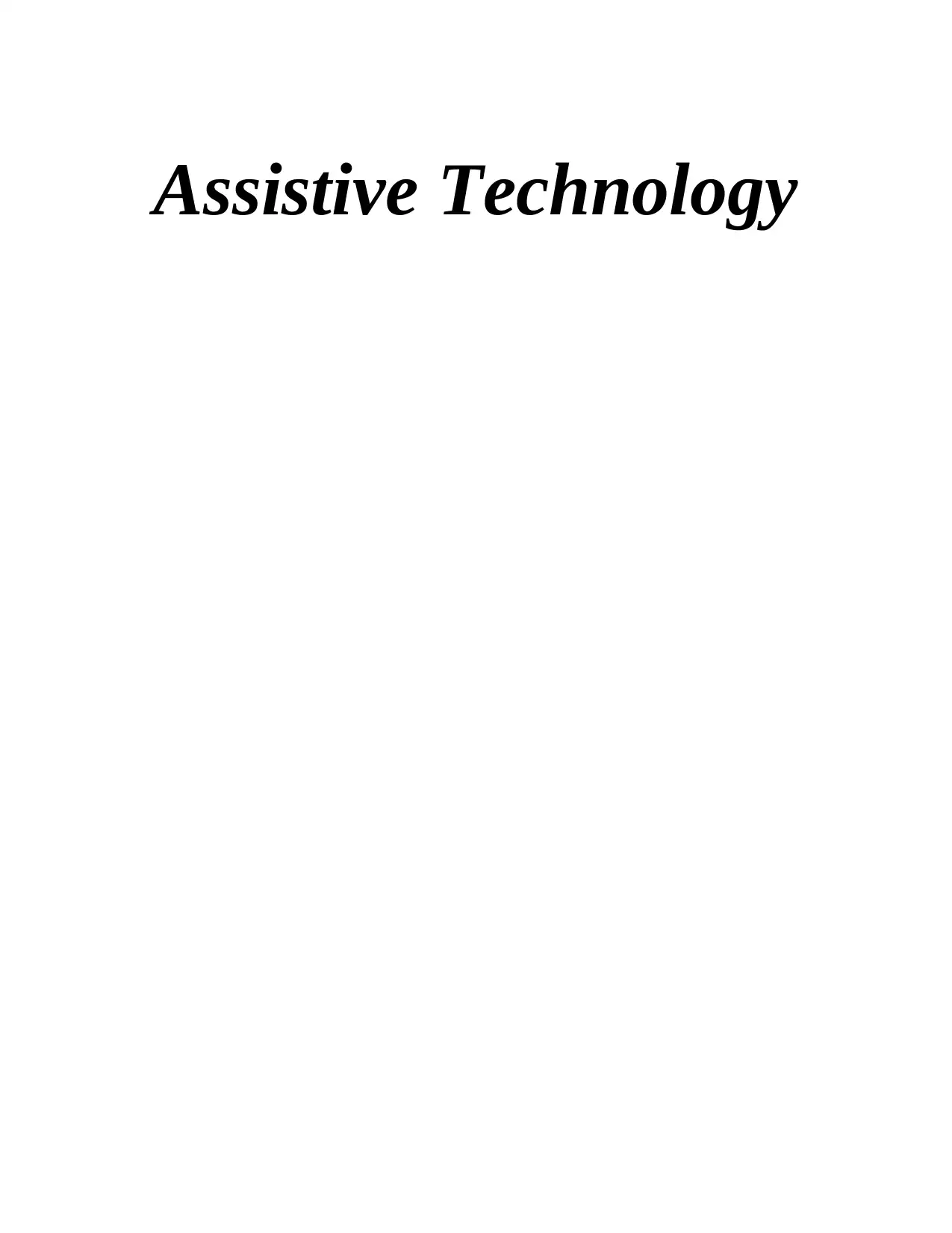
Assistive Technology
Paraphrase This Document
Need a fresh take? Get an instant paraphrase of this document with our AI Paraphraser
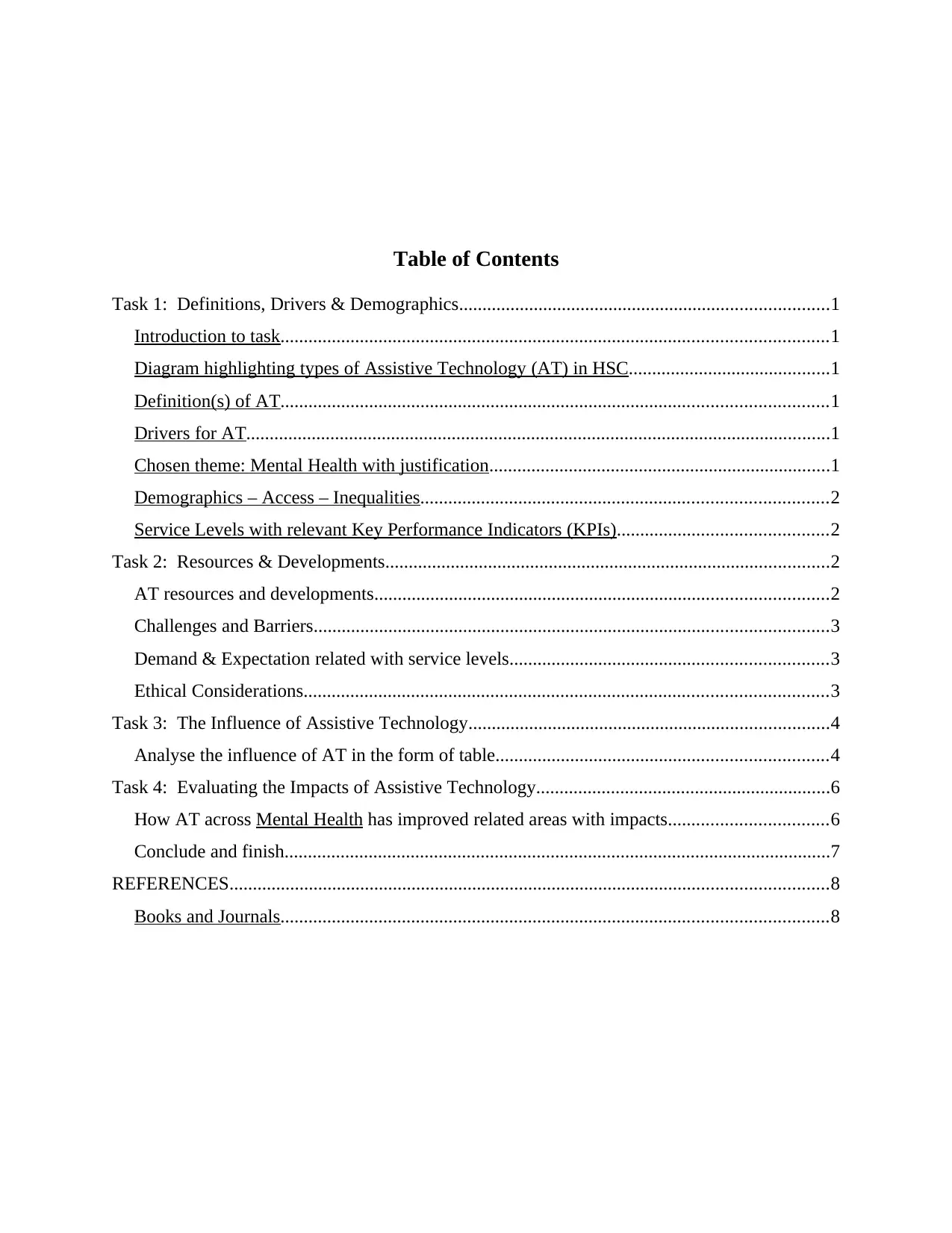
Table of Contents
Task 1: Definitions, Drivers & Demographics...............................................................................1
Introduction to task.....................................................................................................................1
Diagram highlighting types of Assistive Technology (AT) in HSC...........................................1
Definition(s) of AT.....................................................................................................................1
Drivers for AT.............................................................................................................................1
Chosen theme: Mental Health with justification.........................................................................1
Demographics – Access – Inequalities.......................................................................................2
Service Levels with relevant Key Performance Indicators (KPIs).............................................2
Task 2: Resources & Developments...............................................................................................2
AT resources and developments.................................................................................................2
Challenges and Barriers..............................................................................................................3
Demand & Expectation related with service levels....................................................................3
Ethical Considerations................................................................................................................3
Task 3: The Influence of Assistive Technology.............................................................................4
Analyse the influence of AT in the form of table.......................................................................4
Task 4: Evaluating the Impacts of Assistive Technology...............................................................6
How AT across Mental Health has improved related areas with impacts..................................6
Conclude and finish.....................................................................................................................7
REFERENCES................................................................................................................................8
Books and Journals.....................................................................................................................8
Task 1: Definitions, Drivers & Demographics...............................................................................1
Introduction to task.....................................................................................................................1
Diagram highlighting types of Assistive Technology (AT) in HSC...........................................1
Definition(s) of AT.....................................................................................................................1
Drivers for AT.............................................................................................................................1
Chosen theme: Mental Health with justification.........................................................................1
Demographics – Access – Inequalities.......................................................................................2
Service Levels with relevant Key Performance Indicators (KPIs).............................................2
Task 2: Resources & Developments...............................................................................................2
AT resources and developments.................................................................................................2
Challenges and Barriers..............................................................................................................3
Demand & Expectation related with service levels....................................................................3
Ethical Considerations................................................................................................................3
Task 3: The Influence of Assistive Technology.............................................................................4
Analyse the influence of AT in the form of table.......................................................................4
Task 4: Evaluating the Impacts of Assistive Technology...............................................................6
How AT across Mental Health has improved related areas with impacts..................................6
Conclude and finish.....................................................................................................................7
REFERENCES................................................................................................................................8
Books and Journals.....................................................................................................................8
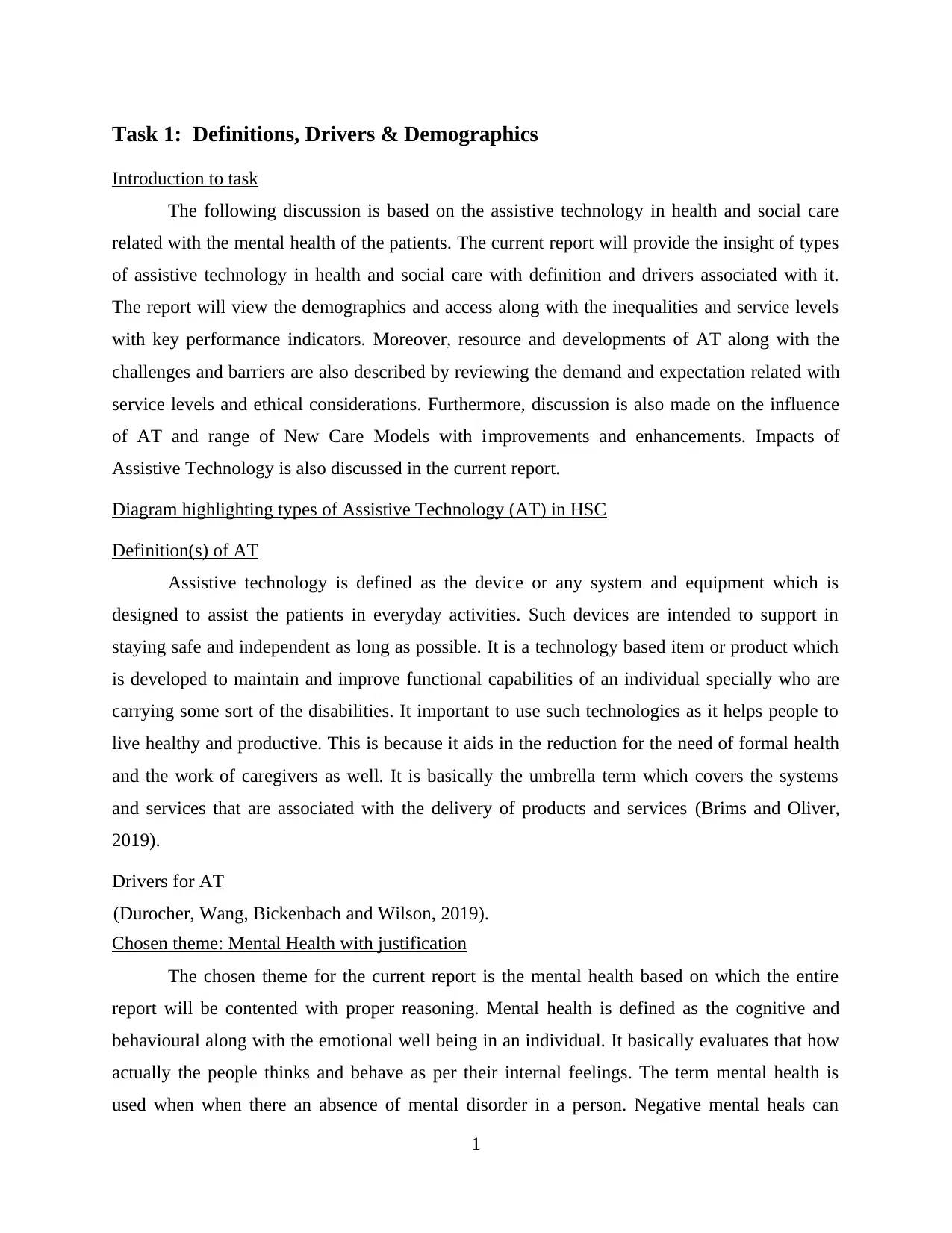
Task 1: Definitions, Drivers & Demographics
Introduction to task
The following discussion is based on the assistive technology in health and social care
related with the mental health of the patients. The current report will provide the insight of types
of assistive technology in health and social care with definition and drivers associated with it.
The report will view the demographics and access along with the inequalities and service levels
with key performance indicators. Moreover, resource and developments of AT along with the
challenges and barriers are also described by reviewing the demand and expectation related with
service levels and ethical considerations. Furthermore, discussion is also made on the influence
of AT and range of New Care Models with improvements and enhancements. Impacts of
Assistive Technology is also discussed in the current report.
Diagram highlighting types of Assistive Technology (AT) in HSC
Definition(s) of AT
Assistive technology is defined as the device or any system and equipment which is
designed to assist the patients in everyday activities. Such devices are intended to support in
staying safe and independent as long as possible. It is a technology based item or product which
is developed to maintain and improve functional capabilities of an individual specially who are
carrying some sort of the disabilities. It important to use such technologies as it helps people to
live healthy and productive. This is because it aids in the reduction for the need of formal health
and the work of caregivers as well. It is basically the umbrella term which covers the systems
and services that are associated with the delivery of products and services (Brims and Oliver,
2019).
Drivers for AT
(Durocher, Wang, Bickenbach and Wilson, 2019).
Chosen theme: Mental Health with justification
The chosen theme for the current report is the mental health based on which the entire
report will be contented with proper reasoning. Mental health is defined as the cognitive and
behavioural along with the emotional well being in an individual. It basically evaluates that how
actually the people thinks and behave as per their internal feelings. The term mental health is
used when when there an absence of mental disorder in a person. Negative mental heals can
1
Introduction to task
The following discussion is based on the assistive technology in health and social care
related with the mental health of the patients. The current report will provide the insight of types
of assistive technology in health and social care with definition and drivers associated with it.
The report will view the demographics and access along with the inequalities and service levels
with key performance indicators. Moreover, resource and developments of AT along with the
challenges and barriers are also described by reviewing the demand and expectation related with
service levels and ethical considerations. Furthermore, discussion is also made on the influence
of AT and range of New Care Models with improvements and enhancements. Impacts of
Assistive Technology is also discussed in the current report.
Diagram highlighting types of Assistive Technology (AT) in HSC
Definition(s) of AT
Assistive technology is defined as the device or any system and equipment which is
designed to assist the patients in everyday activities. Such devices are intended to support in
staying safe and independent as long as possible. It is a technology based item or product which
is developed to maintain and improve functional capabilities of an individual specially who are
carrying some sort of the disabilities. It important to use such technologies as it helps people to
live healthy and productive. This is because it aids in the reduction for the need of formal health
and the work of caregivers as well. It is basically the umbrella term which covers the systems
and services that are associated with the delivery of products and services (Brims and Oliver,
2019).
Drivers for AT
(Durocher, Wang, Bickenbach and Wilson, 2019).
Chosen theme: Mental Health with justification
The chosen theme for the current report is the mental health based on which the entire
report will be contented with proper reasoning. Mental health is defined as the cognitive and
behavioural along with the emotional well being in an individual. It basically evaluates that how
actually the people thinks and behave as per their internal feelings. The term mental health is
used when when there an absence of mental disorder in a person. Negative mental heals can
1
⊘ This is a preview!⊘
Do you want full access?
Subscribe today to unlock all pages.

Trusted by 1+ million students worldwide
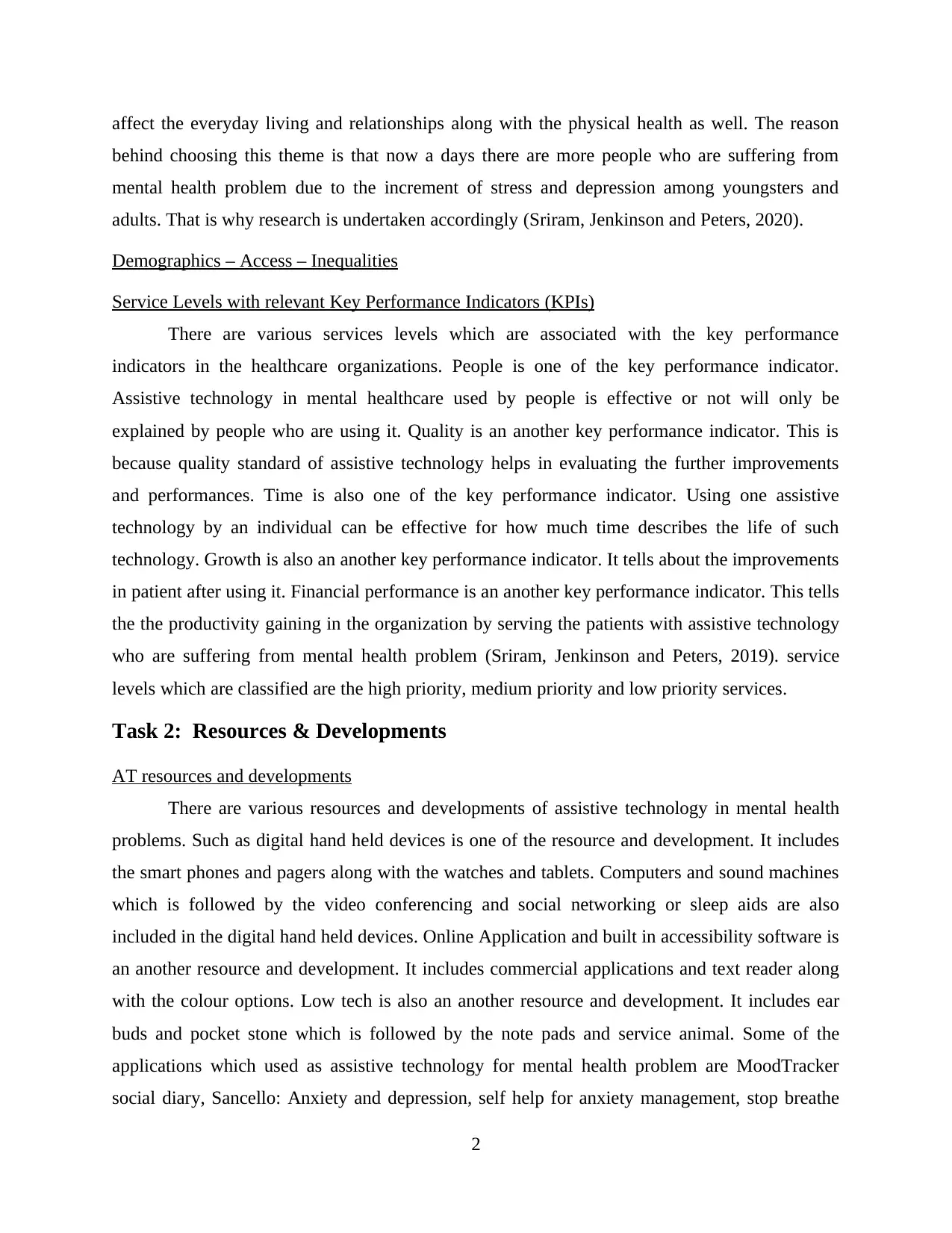
affect the everyday living and relationships along with the physical health as well. The reason
behind choosing this theme is that now a days there are more people who are suffering from
mental health problem due to the increment of stress and depression among youngsters and
adults. That is why research is undertaken accordingly (Sriram, Jenkinson and Peters, 2020).
Demographics – Access – Inequalities
Service Levels with relevant Key Performance Indicators (KPIs)
There are various services levels which are associated with the key performance
indicators in the healthcare organizations. People is one of the key performance indicator.
Assistive technology in mental healthcare used by people is effective or not will only be
explained by people who are using it. Quality is an another key performance indicator. This is
because quality standard of assistive technology helps in evaluating the further improvements
and performances. Time is also one of the key performance indicator. Using one assistive
technology by an individual can be effective for how much time describes the life of such
technology. Growth is also an another key performance indicator. It tells about the improvements
in patient after using it. Financial performance is an another key performance indicator. This tells
the the productivity gaining in the organization by serving the patients with assistive technology
who are suffering from mental health problem (Sriram, Jenkinson and Peters, 2019). service
levels which are classified are the high priority, medium priority and low priority services.
Task 2: Resources & Developments
AT resources and developments
There are various resources and developments of assistive technology in mental health
problems. Such as digital hand held devices is one of the resource and development. It includes
the smart phones and pagers along with the watches and tablets. Computers and sound machines
which is followed by the video conferencing and social networking or sleep aids are also
included in the digital hand held devices. Online Application and built in accessibility software is
an another resource and development. It includes commercial applications and text reader along
with the colour options. Low tech is also an another resource and development. It includes ear
buds and pocket stone which is followed by the note pads and service animal. Some of the
applications which used as assistive technology for mental health problem are MoodTracker
social diary, Sancello: Anxiety and depression, self help for anxiety management, stop breathe
2
behind choosing this theme is that now a days there are more people who are suffering from
mental health problem due to the increment of stress and depression among youngsters and
adults. That is why research is undertaken accordingly (Sriram, Jenkinson and Peters, 2020).
Demographics – Access – Inequalities
Service Levels with relevant Key Performance Indicators (KPIs)
There are various services levels which are associated with the key performance
indicators in the healthcare organizations. People is one of the key performance indicator.
Assistive technology in mental healthcare used by people is effective or not will only be
explained by people who are using it. Quality is an another key performance indicator. This is
because quality standard of assistive technology helps in evaluating the further improvements
and performances. Time is also one of the key performance indicator. Using one assistive
technology by an individual can be effective for how much time describes the life of such
technology. Growth is also an another key performance indicator. It tells about the improvements
in patient after using it. Financial performance is an another key performance indicator. This tells
the the productivity gaining in the organization by serving the patients with assistive technology
who are suffering from mental health problem (Sriram, Jenkinson and Peters, 2019). service
levels which are classified are the high priority, medium priority and low priority services.
Task 2: Resources & Developments
AT resources and developments
There are various resources and developments of assistive technology in mental health
problems. Such as digital hand held devices is one of the resource and development. It includes
the smart phones and pagers along with the watches and tablets. Computers and sound machines
which is followed by the video conferencing and social networking or sleep aids are also
included in the digital hand held devices. Online Application and built in accessibility software is
an another resource and development. It includes commercial applications and text reader along
with the colour options. Low tech is also an another resource and development. It includes ear
buds and pocket stone which is followed by the note pads and service animal. Some of the
applications which used as assistive technology for mental health problem are MoodTracker
social diary, Sancello: Anxiety and depression, self help for anxiety management, stop breathe
2
Paraphrase This Document
Need a fresh take? Get an instant paraphrase of this document with our AI Paraphraser
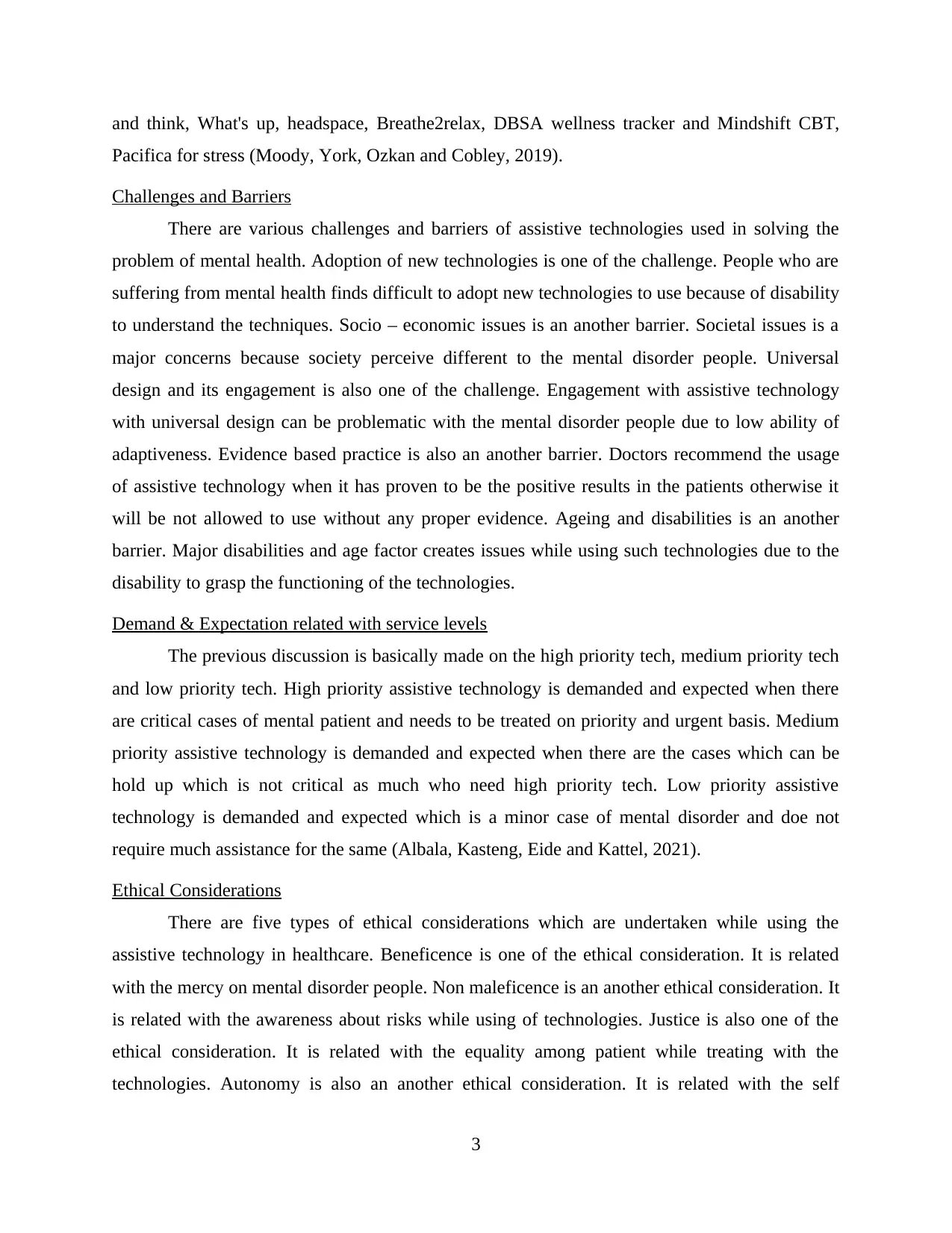
and think, What's up, headspace, Breathe2relax, DBSA wellness tracker and Mindshift CBT,
Pacifica for stress (Moody, York, Ozkan and Cobley, 2019).
Challenges and Barriers
There are various challenges and barriers of assistive technologies used in solving the
problem of mental health. Adoption of new technologies is one of the challenge. People who are
suffering from mental health finds difficult to adopt new technologies to use because of disability
to understand the techniques. Socio – economic issues is an another barrier. Societal issues is a
major concerns because society perceive different to the mental disorder people. Universal
design and its engagement is also one of the challenge. Engagement with assistive technology
with universal design can be problematic with the mental disorder people due to low ability of
adaptiveness. Evidence based practice is also an another barrier. Doctors recommend the usage
of assistive technology when it has proven to be the positive results in the patients otherwise it
will be not allowed to use without any proper evidence. Ageing and disabilities is an another
barrier. Major disabilities and age factor creates issues while using such technologies due to the
disability to grasp the functioning of the technologies.
Demand & Expectation related with service levels
The previous discussion is basically made on the high priority tech, medium priority tech
and low priority tech. High priority assistive technology is demanded and expected when there
are critical cases of mental patient and needs to be treated on priority and urgent basis. Medium
priority assistive technology is demanded and expected when there are the cases which can be
hold up which is not critical as much who need high priority tech. Low priority assistive
technology is demanded and expected which is a minor case of mental disorder and doe not
require much assistance for the same (Albala, Kasteng, Eide and Kattel, 2021).
Ethical Considerations
There are five types of ethical considerations which are undertaken while using the
assistive technology in healthcare. Beneficence is one of the ethical consideration. It is related
with the mercy on mental disorder people. Non maleficence is an another ethical consideration. It
is related with the awareness about risks while using of technologies. Justice is also one of the
ethical consideration. It is related with the equality among patient while treating with the
technologies. Autonomy is also an another ethical consideration. It is related with the self
3
Pacifica for stress (Moody, York, Ozkan and Cobley, 2019).
Challenges and Barriers
There are various challenges and barriers of assistive technologies used in solving the
problem of mental health. Adoption of new technologies is one of the challenge. People who are
suffering from mental health finds difficult to adopt new technologies to use because of disability
to understand the techniques. Socio – economic issues is an another barrier. Societal issues is a
major concerns because society perceive different to the mental disorder people. Universal
design and its engagement is also one of the challenge. Engagement with assistive technology
with universal design can be problematic with the mental disorder people due to low ability of
adaptiveness. Evidence based practice is also an another barrier. Doctors recommend the usage
of assistive technology when it has proven to be the positive results in the patients otherwise it
will be not allowed to use without any proper evidence. Ageing and disabilities is an another
barrier. Major disabilities and age factor creates issues while using such technologies due to the
disability to grasp the functioning of the technologies.
Demand & Expectation related with service levels
The previous discussion is basically made on the high priority tech, medium priority tech
and low priority tech. High priority assistive technology is demanded and expected when there
are critical cases of mental patient and needs to be treated on priority and urgent basis. Medium
priority assistive technology is demanded and expected when there are the cases which can be
hold up which is not critical as much who need high priority tech. Low priority assistive
technology is demanded and expected which is a minor case of mental disorder and doe not
require much assistance for the same (Albala, Kasteng, Eide and Kattel, 2021).
Ethical Considerations
There are five types of ethical considerations which are undertaken while using the
assistive technology in healthcare. Beneficence is one of the ethical consideration. It is related
with the mercy on mental disorder people. Non maleficence is an another ethical consideration. It
is related with the awareness about risks while using of technologies. Justice is also one of the
ethical consideration. It is related with the equality among patient while treating with the
technologies. Autonomy is also an another ethical consideration. It is related with the self
3
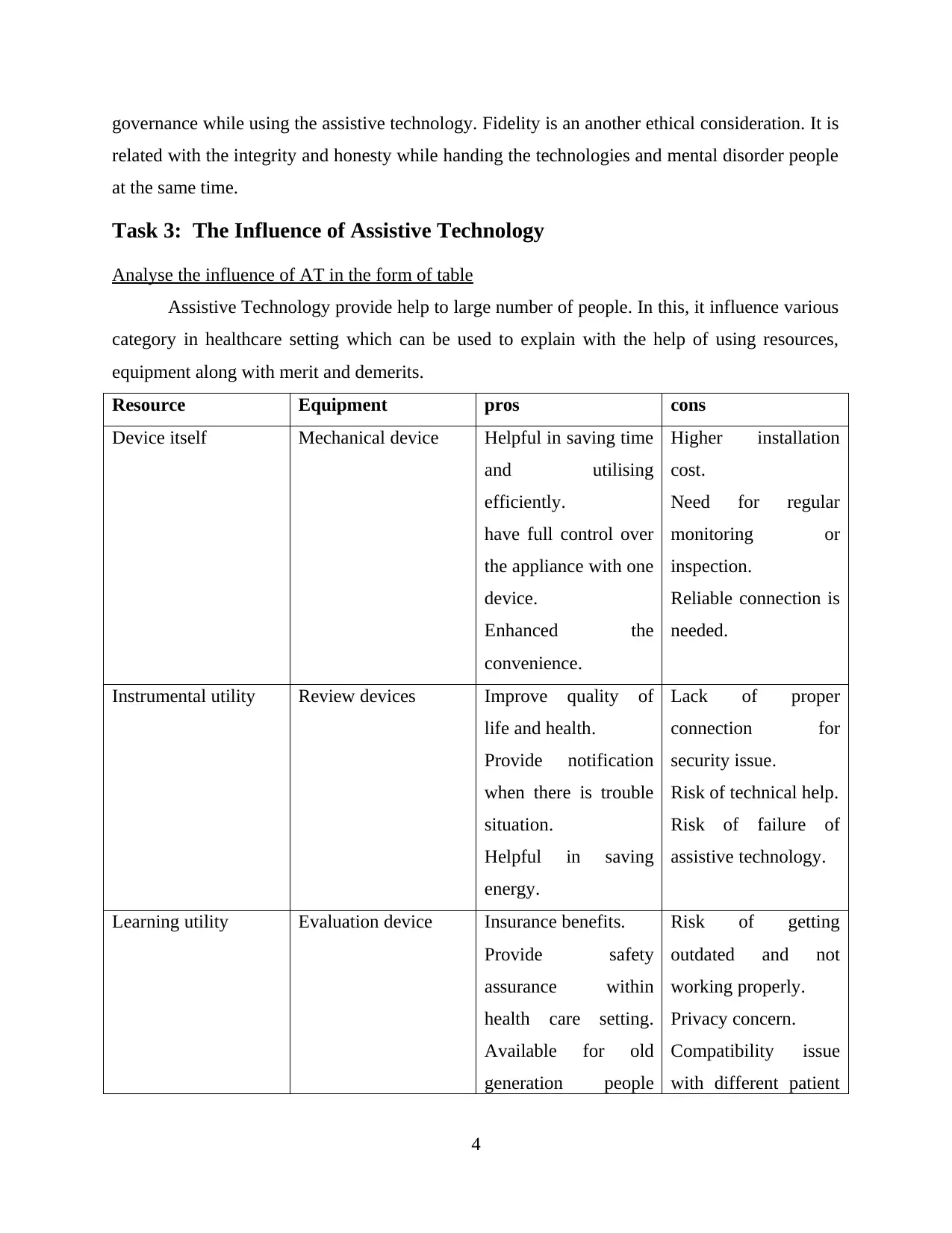
governance while using the assistive technology. Fidelity is an another ethical consideration. It is
related with the integrity and honesty while handing the technologies and mental disorder people
at the same time.
Task 3: The Influence of Assistive Technology
Analyse the influence of AT in the form of table
Assistive Technology provide help to large number of people. In this, it influence various
category in healthcare setting which can be used to explain with the help of using resources,
equipment along with merit and demerits.
Resource Equipment pros cons
Device itself Mechanical device Helpful in saving time
and utilising
efficiently.
have full control over
the appliance with one
device.
Enhanced the
convenience.
Higher installation
cost.
Need for regular
monitoring or
inspection.
Reliable connection is
needed.
Instrumental utility Review devices Improve quality of
life and health.
Provide notification
when there is trouble
situation.
Helpful in saving
energy.
Lack of proper
connection for
security issue.
Risk of technical help.
Risk of failure of
assistive technology.
Learning utility Evaluation device Insurance benefits.
Provide safety
assurance within
health care setting.
Available for old
generation people
Risk of getting
outdated and not
working properly.
Privacy concern.
Compatibility issue
with different patient
4
related with the integrity and honesty while handing the technologies and mental disorder people
at the same time.
Task 3: The Influence of Assistive Technology
Analyse the influence of AT in the form of table
Assistive Technology provide help to large number of people. In this, it influence various
category in healthcare setting which can be used to explain with the help of using resources,
equipment along with merit and demerits.
Resource Equipment pros cons
Device itself Mechanical device Helpful in saving time
and utilising
efficiently.
have full control over
the appliance with one
device.
Enhanced the
convenience.
Higher installation
cost.
Need for regular
monitoring or
inspection.
Reliable connection is
needed.
Instrumental utility Review devices Improve quality of
life and health.
Provide notification
when there is trouble
situation.
Helpful in saving
energy.
Lack of proper
connection for
security issue.
Risk of technical help.
Risk of failure of
assistive technology.
Learning utility Evaluation device Insurance benefits.
Provide safety
assurance within
health care setting.
Available for old
generation people
Risk of getting
outdated and not
working properly.
Privacy concern.
Compatibility issue
with different patient
4
⊘ This is a preview!⊘
Do you want full access?
Subscribe today to unlock all pages.

Trusted by 1+ million students worldwide
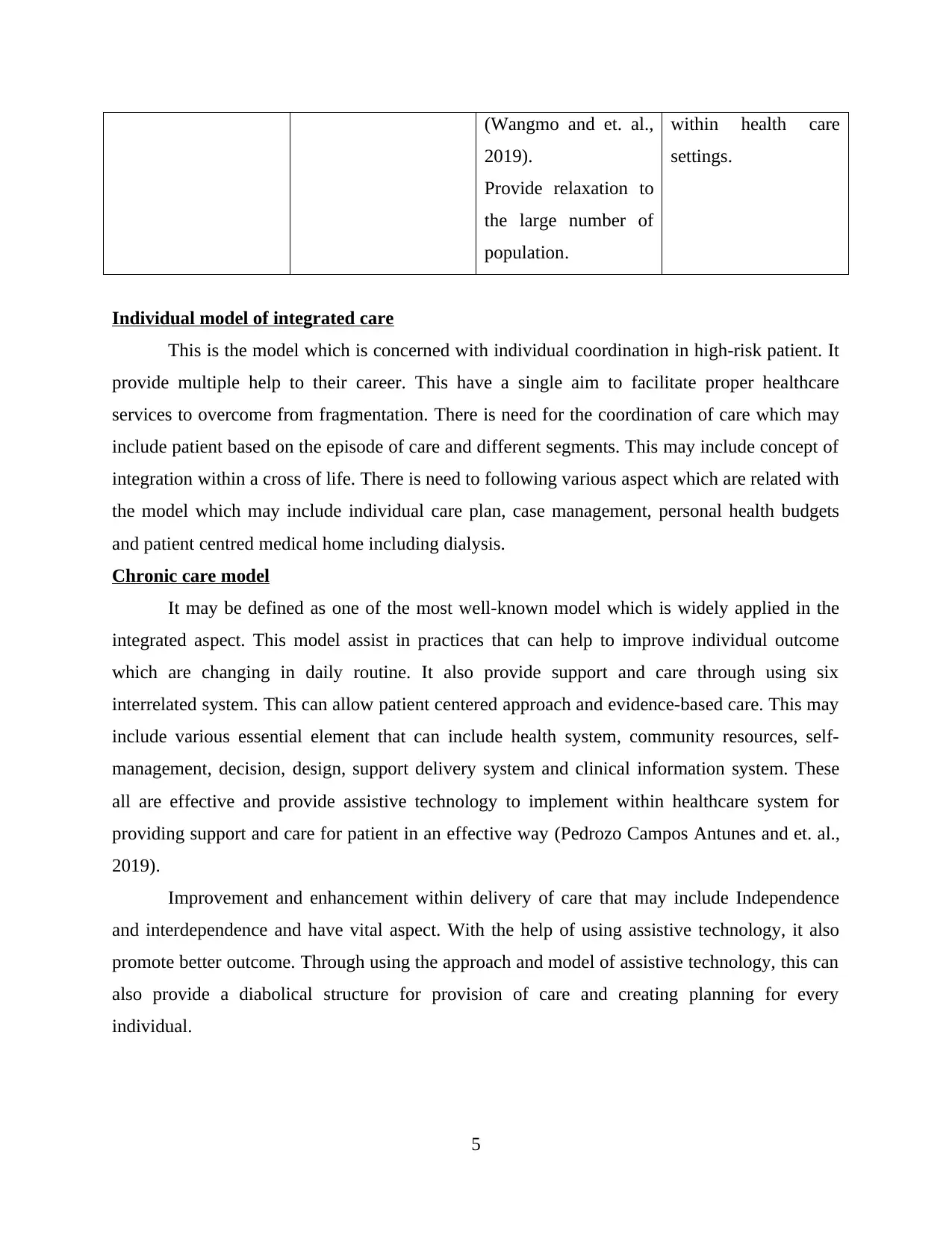
(Wangmo and et. al.,
2019).
Provide relaxation to
the large number of
population.
within health care
settings.
Individual model of integrated care
This is the model which is concerned with individual coordination in high-risk patient. It
provide multiple help to their career. This have a single aim to facilitate proper healthcare
services to overcome from fragmentation. There is need for the coordination of care which may
include patient based on the episode of care and different segments. This may include concept of
integration within a cross of life. There is need to following various aspect which are related with
the model which may include individual care plan, case management, personal health budgets
and patient centred medical home including dialysis.
Chronic care model
It may be defined as one of the most well-known model which is widely applied in the
integrated aspect. This model assist in practices that can help to improve individual outcome
which are changing in daily routine. It also provide support and care through using six
interrelated system. This can allow patient centered approach and evidence-based care. This may
include various essential element that can include health system, community resources, self-
management, decision, design, support delivery system and clinical information system. These
all are effective and provide assistive technology to implement within healthcare system for
providing support and care for patient in an effective way (Pedrozo Campos Antunes and et. al.,
2019).
Improvement and enhancement within delivery of care that may include Independence
and interdependence and have vital aspect. With the help of using assistive technology, it also
promote better outcome. Through using the approach and model of assistive technology, this can
also provide a diabolical structure for provision of care and creating planning for every
individual.
5
2019).
Provide relaxation to
the large number of
population.
within health care
settings.
Individual model of integrated care
This is the model which is concerned with individual coordination in high-risk patient. It
provide multiple help to their career. This have a single aim to facilitate proper healthcare
services to overcome from fragmentation. There is need for the coordination of care which may
include patient based on the episode of care and different segments. This may include concept of
integration within a cross of life. There is need to following various aspect which are related with
the model which may include individual care plan, case management, personal health budgets
and patient centred medical home including dialysis.
Chronic care model
It may be defined as one of the most well-known model which is widely applied in the
integrated aspect. This model assist in practices that can help to improve individual outcome
which are changing in daily routine. It also provide support and care through using six
interrelated system. This can allow patient centered approach and evidence-based care. This may
include various essential element that can include health system, community resources, self-
management, decision, design, support delivery system and clinical information system. These
all are effective and provide assistive technology to implement within healthcare system for
providing support and care for patient in an effective way (Pedrozo Campos Antunes and et. al.,
2019).
Improvement and enhancement within delivery of care that may include Independence
and interdependence and have vital aspect. With the help of using assistive technology, it also
promote better outcome. Through using the approach and model of assistive technology, this can
also provide a diabolical structure for provision of care and creating planning for every
individual.
5
Paraphrase This Document
Need a fresh take? Get an instant paraphrase of this document with our AI Paraphraser
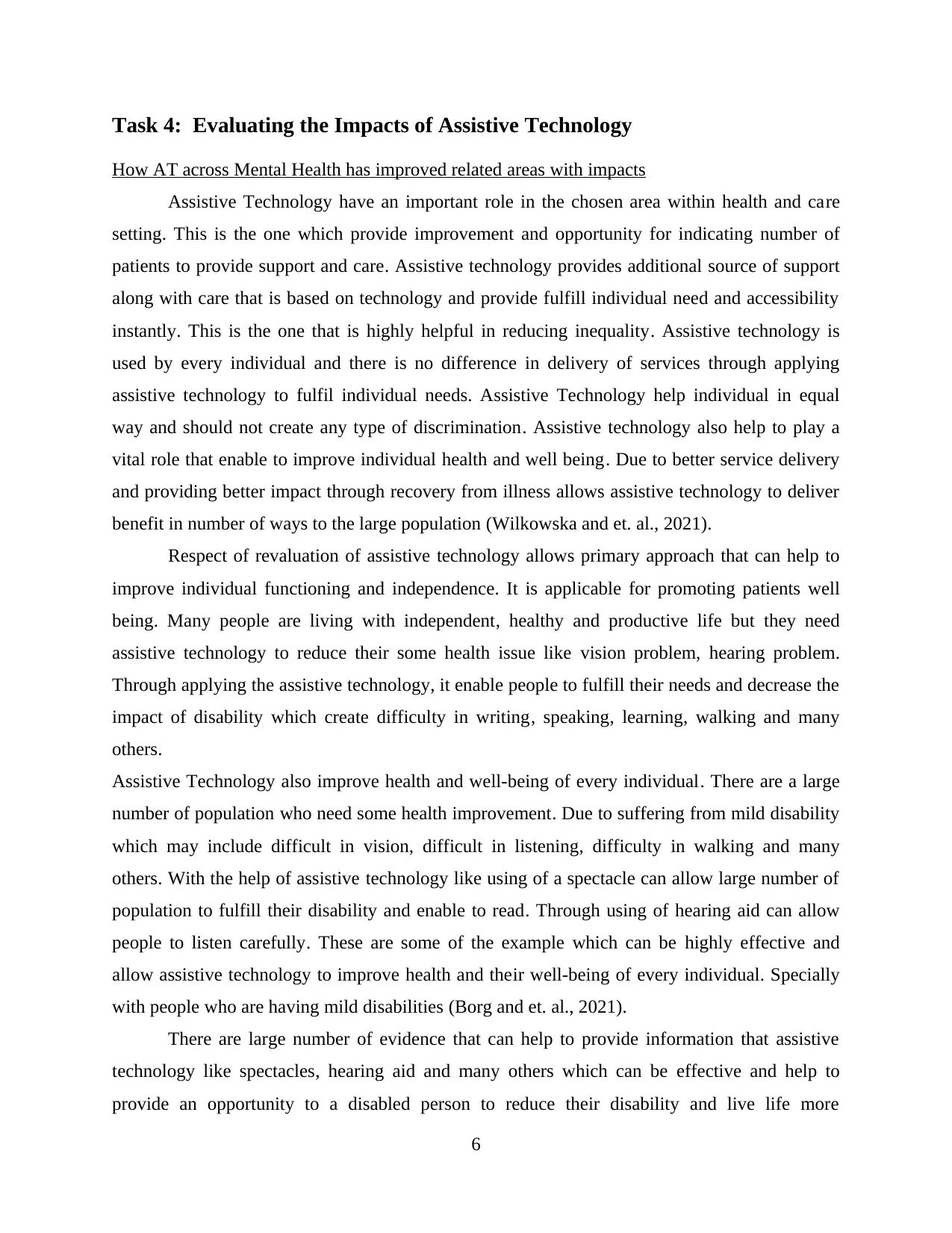
Task 4: Evaluating the Impacts of Assistive Technology
How AT across Mental Health has improved related areas with impacts
Assistive Technology have an important role in the chosen area within health and care
setting. This is the one which provide improvement and opportunity for indicating number of
patients to provide support and care. Assistive technology provides additional source of support
along with care that is based on technology and provide fulfill individual need and accessibility
instantly. This is the one that is highly helpful in reducing inequality. Assistive technology is
used by every individual and there is no difference in delivery of services through applying
assistive technology to fulfil individual needs. Assistive Technology help individual in equal
way and should not create any type of discrimination. Assistive technology also help to play a
vital role that enable to improve individual health and well being. Due to better service delivery
and providing better impact through recovery from illness allows assistive technology to deliver
benefit in number of ways to the large population (Wilkowska and et. al., 2021).
Respect of revaluation of assistive technology allows primary approach that can help to
improve individual functioning and independence. It is applicable for promoting patients well
being. Many people are living with independent, healthy and productive life but they need
assistive technology to reduce their some health issue like vision problem, hearing problem.
Through applying the assistive technology, it enable people to fulfill their needs and decrease the
impact of disability which create difficulty in writing, speaking, learning, walking and many
others.
Assistive Technology also improve health and well-being of every individual. There are a large
number of population who need some health improvement. Due to suffering from mild disability
which may include difficult in vision, difficult in listening, difficulty in walking and many
others. With the help of assistive technology like using of a spectacle can allow large number of
population to fulfill their disability and enable to read. Through using of hearing aid can allow
people to listen carefully. These are some of the example which can be highly effective and
allow assistive technology to improve health and their well-being of every individual. Specially
with people who are having mild disabilities (Borg and et. al., 2021).
There are large number of evidence that can help to provide information that assistive
technology like spectacles, hearing aid and many others which can be effective and help to
provide an opportunity to a disabled person to reduce their disability and live life more
6
How AT across Mental Health has improved related areas with impacts
Assistive Technology have an important role in the chosen area within health and care
setting. This is the one which provide improvement and opportunity for indicating number of
patients to provide support and care. Assistive technology provides additional source of support
along with care that is based on technology and provide fulfill individual need and accessibility
instantly. This is the one that is highly helpful in reducing inequality. Assistive technology is
used by every individual and there is no difference in delivery of services through applying
assistive technology to fulfil individual needs. Assistive Technology help individual in equal
way and should not create any type of discrimination. Assistive technology also help to play a
vital role that enable to improve individual health and well being. Due to better service delivery
and providing better impact through recovery from illness allows assistive technology to deliver
benefit in number of ways to the large population (Wilkowska and et. al., 2021).
Respect of revaluation of assistive technology allows primary approach that can help to
improve individual functioning and independence. It is applicable for promoting patients well
being. Many people are living with independent, healthy and productive life but they need
assistive technology to reduce their some health issue like vision problem, hearing problem.
Through applying the assistive technology, it enable people to fulfill their needs and decrease the
impact of disability which create difficulty in writing, speaking, learning, walking and many
others.
Assistive Technology also improve health and well-being of every individual. There are a large
number of population who need some health improvement. Due to suffering from mild disability
which may include difficult in vision, difficult in listening, difficulty in walking and many
others. With the help of assistive technology like using of a spectacle can allow large number of
population to fulfill their disability and enable to read. Through using of hearing aid can allow
people to listen carefully. These are some of the example which can be highly effective and
allow assistive technology to improve health and their well-being of every individual. Specially
with people who are having mild disabilities (Borg and et. al., 2021).
There are large number of evidence that can help to provide information that assistive
technology like spectacles, hearing aid and many others which can be effective and help to
provide an opportunity to a disabled person to reduce their disability and live life more
6
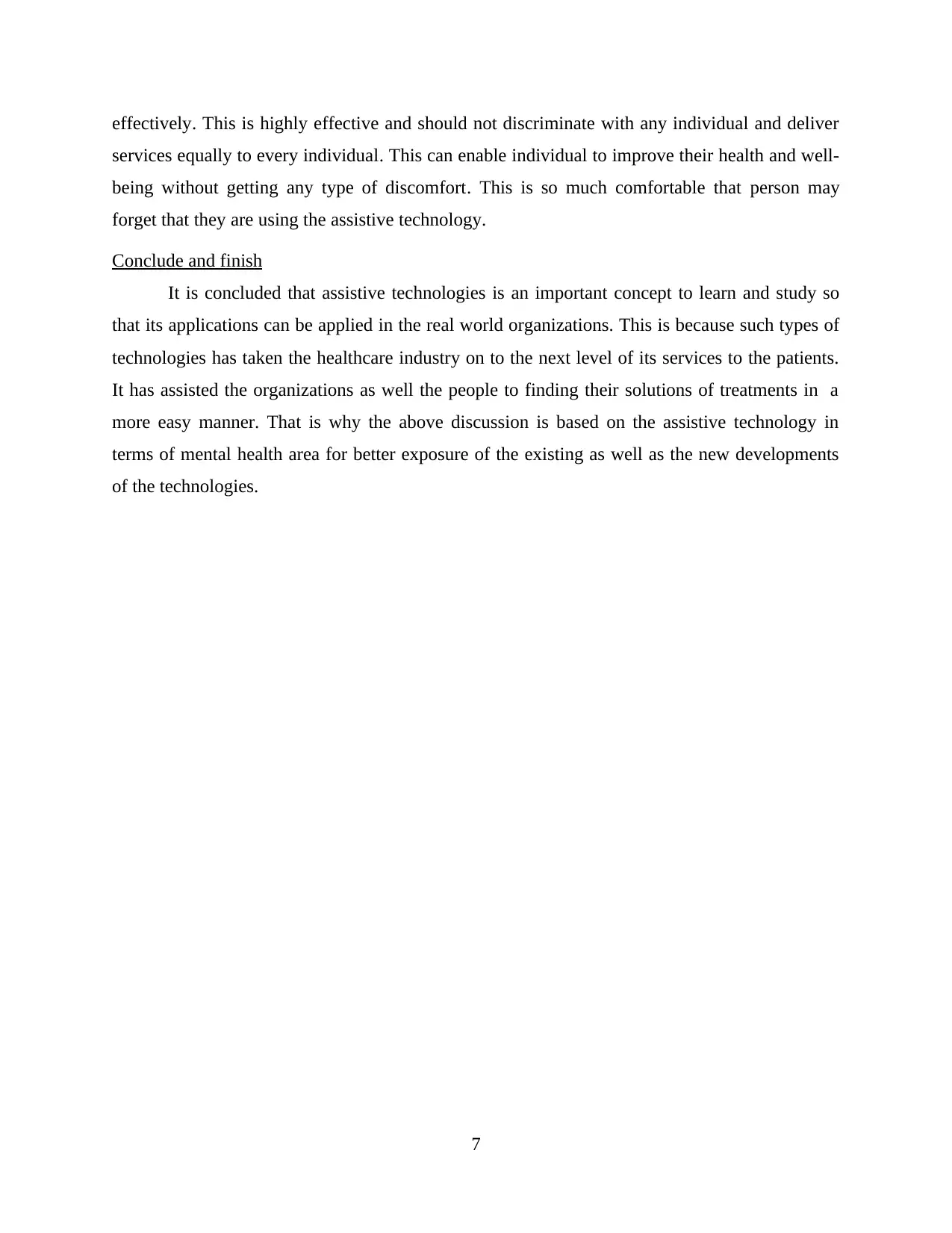
effectively. This is highly effective and should not discriminate with any individual and deliver
services equally to every individual. This can enable individual to improve their health and well-
being without getting any type of discomfort. This is so much comfortable that person may
forget that they are using the assistive technology.
Conclude and finish
It is concluded that assistive technologies is an important concept to learn and study so
that its applications can be applied in the real world organizations. This is because such types of
technologies has taken the healthcare industry on to the next level of its services to the patients.
It has assisted the organizations as well the people to finding their solutions of treatments in a
more easy manner. That is why the above discussion is based on the assistive technology in
terms of mental health area for better exposure of the existing as well as the new developments
of the technologies.
7
services equally to every individual. This can enable individual to improve their health and well-
being without getting any type of discomfort. This is so much comfortable that person may
forget that they are using the assistive technology.
Conclude and finish
It is concluded that assistive technologies is an important concept to learn and study so
that its applications can be applied in the real world organizations. This is because such types of
technologies has taken the healthcare industry on to the next level of its services to the patients.
It has assisted the organizations as well the people to finding their solutions of treatments in a
more easy manner. That is why the above discussion is based on the assistive technology in
terms of mental health area for better exposure of the existing as well as the new developments
of the technologies.
7
⊘ This is a preview!⊘
Do you want full access?
Subscribe today to unlock all pages.

Trusted by 1+ million students worldwide
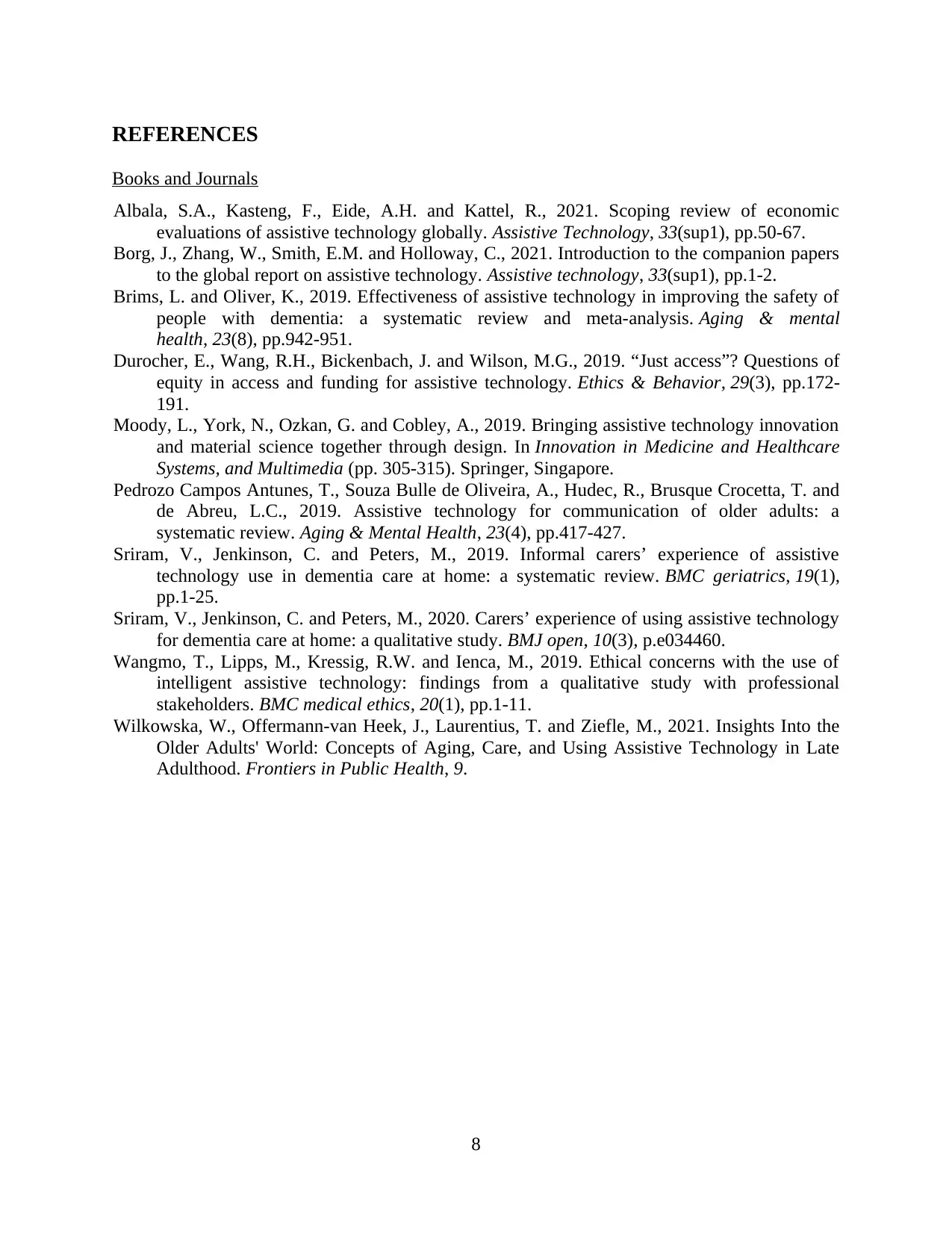
REFERENCES
Books and Journals
Albala, S.A., Kasteng, F., Eide, A.H. and Kattel, R., 2021. Scoping review of economic
evaluations of assistive technology globally. Assistive Technology, 33(sup1), pp.50-67.
Borg, J., Zhang, W., Smith, E.M. and Holloway, C., 2021. Introduction to the companion papers
to the global report on assistive technology. Assistive technology, 33(sup1), pp.1-2.
Brims, L. and Oliver, K., 2019. Effectiveness of assistive technology in improving the safety of
people with dementia: a systematic review and meta-analysis. Aging & mental
health, 23(8), pp.942-951.
Durocher, E., Wang, R.H., Bickenbach, J. and Wilson, M.G., 2019. “Just access”? Questions of
equity in access and funding for assistive technology. Ethics & Behavior, 29(3), pp.172-
191.
Moody, L., York, N., Ozkan, G. and Cobley, A., 2019. Bringing assistive technology innovation
and material science together through design. In Innovation in Medicine and Healthcare
Systems, and Multimedia (pp. 305-315). Springer, Singapore.
Pedrozo Campos Antunes, T., Souza Bulle de Oliveira, A., Hudec, R., Brusque Crocetta, T. and
de Abreu, L.C., 2019. Assistive technology for communication of older adults: a
systematic review. Aging & Mental Health, 23(4), pp.417-427.
Sriram, V., Jenkinson, C. and Peters, M., 2019. Informal carers’ experience of assistive
technology use in dementia care at home: a systematic review. BMC geriatrics, 19(1),
pp.1-25.
Sriram, V., Jenkinson, C. and Peters, M., 2020. Carers’ experience of using assistive technology
for dementia care at home: a qualitative study. BMJ open, 10(3), p.e034460.
Wangmo, T., Lipps, M., Kressig, R.W. and Ienca, M., 2019. Ethical concerns with the use of
intelligent assistive technology: findings from a qualitative study with professional
stakeholders. BMC medical ethics, 20(1), pp.1-11.
Wilkowska, W., Offermann-van Heek, J., Laurentius, T. and Ziefle, M., 2021. Insights Into the
Older Adults' World: Concepts of Aging, Care, and Using Assistive Technology in Late
Adulthood. Frontiers in Public Health, 9.
8
Books and Journals
Albala, S.A., Kasteng, F., Eide, A.H. and Kattel, R., 2021. Scoping review of economic
evaluations of assistive technology globally. Assistive Technology, 33(sup1), pp.50-67.
Borg, J., Zhang, W., Smith, E.M. and Holloway, C., 2021. Introduction to the companion papers
to the global report on assistive technology. Assistive technology, 33(sup1), pp.1-2.
Brims, L. and Oliver, K., 2019. Effectiveness of assistive technology in improving the safety of
people with dementia: a systematic review and meta-analysis. Aging & mental
health, 23(8), pp.942-951.
Durocher, E., Wang, R.H., Bickenbach, J. and Wilson, M.G., 2019. “Just access”? Questions of
equity in access and funding for assistive technology. Ethics & Behavior, 29(3), pp.172-
191.
Moody, L., York, N., Ozkan, G. and Cobley, A., 2019. Bringing assistive technology innovation
and material science together through design. In Innovation in Medicine and Healthcare
Systems, and Multimedia (pp. 305-315). Springer, Singapore.
Pedrozo Campos Antunes, T., Souza Bulle de Oliveira, A., Hudec, R., Brusque Crocetta, T. and
de Abreu, L.C., 2019. Assistive technology for communication of older adults: a
systematic review. Aging & Mental Health, 23(4), pp.417-427.
Sriram, V., Jenkinson, C. and Peters, M., 2019. Informal carers’ experience of assistive
technology use in dementia care at home: a systematic review. BMC geriatrics, 19(1),
pp.1-25.
Sriram, V., Jenkinson, C. and Peters, M., 2020. Carers’ experience of using assistive technology
for dementia care at home: a qualitative study. BMJ open, 10(3), p.e034460.
Wangmo, T., Lipps, M., Kressig, R.W. and Ienca, M., 2019. Ethical concerns with the use of
intelligent assistive technology: findings from a qualitative study with professional
stakeholders. BMC medical ethics, 20(1), pp.1-11.
Wilkowska, W., Offermann-van Heek, J., Laurentius, T. and Ziefle, M., 2021. Insights Into the
Older Adults' World: Concepts of Aging, Care, and Using Assistive Technology in Late
Adulthood. Frontiers in Public Health, 9.
8
1 out of 10
Related Documents
Your All-in-One AI-Powered Toolkit for Academic Success.
+13062052269
info@desklib.com
Available 24*7 on WhatsApp / Email
![[object Object]](/_next/static/media/star-bottom.7253800d.svg)
Unlock your academic potential
Copyright © 2020–2025 A2Z Services. All Rights Reserved. Developed and managed by ZUCOL.





